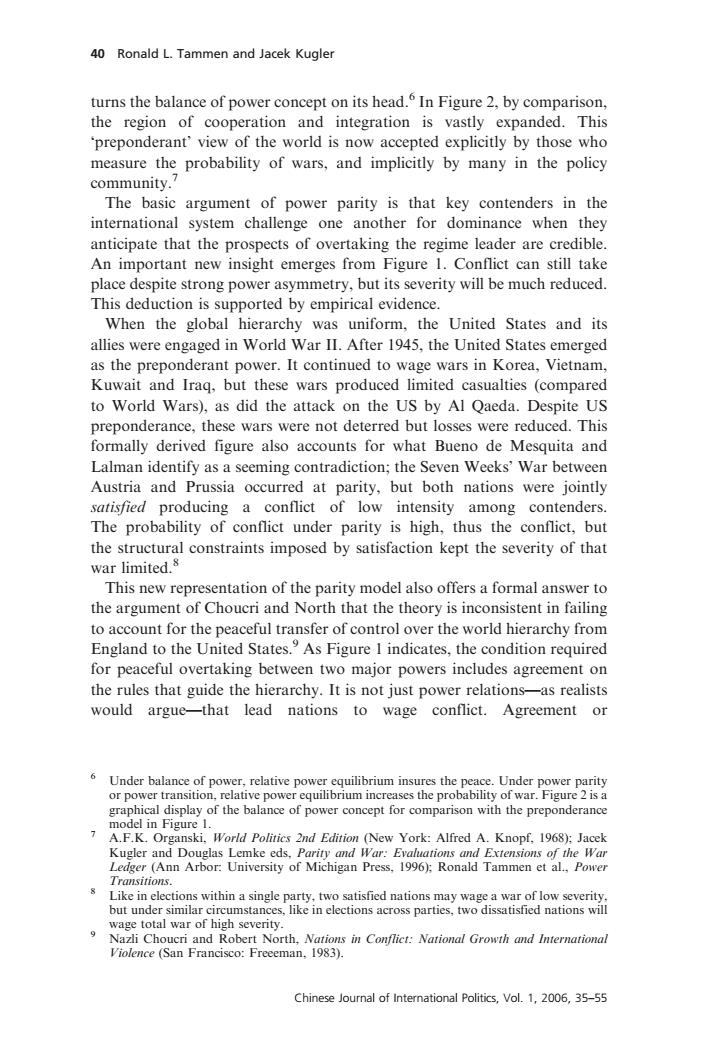正在加载图片...

40 Ronald L.Tammen and Jacek Kugler turns the balance of power concept on its head.In Figure 2,by comparison, the region of cooperation and integration is vastly expanded.This preponderant'view of the world is now accepted explicitly by those who measure the probability of wars,and implicitly by many in the policy community. The basic argument of power parity is that key contenders in the international system challenge one another for dominance when they anticipate that the prospects of overtaking the regime leader are credible An important new insight emerges from Figure 1.Conflict can still take place despite strong power asymmetry,but its severity will be much reduced. This deduction is supported by empirical evidence. When the global hierarchy was uniform,the United States and its allies were engaged in World War II.After 1945,the United States emerged as the preponderant power.It continued to wage wars in Korea,Vietnam, Kuwait and Iraq,but these wars produced limited casualties (compared to World Wars),as did the attack on the US by Al Qaeda.Despite US preponderance,these wars were not deterred but losses were reduced.This formally derived figure also accounts for what Bueno de Mesquita and Lalman identify as a seeming contradiction;the Seven Weeks'War between Austria and Prussia occurred at parity,but both nations were jointly satisfied producing a conflict of low intensity among contenders. The probability of conflict under parity is high,thus the conflict,but the structural constraints imposed by satisfaction kept the severity of that war limited.8 This new representation of the parity model also offers a formal answer to the argument of Choucri and North that the theory is inconsistent in failing to account for the peaceful transfer of control over the world hierarchy from England to the United States.As Figure I indicates,the condition required for peaceful overtaking between two major powers includes agreement on the rules that guide the hierarchy.It is not just power relations-as realists would argue-that lead nations to wage conflict.Agreement or 6 Under balance of power,relative power equilibrium insures the peace.Under power parity or power transition,relative power equilibrium increases the probability of war.Figure 2 is a graphical display of the balance of power concept for comparison with the preponderance model in Figure 1. A.F.K.Organski,World Politics 2nd Edition (New York:Alfred A.Knopf,1968):Jacek Kugler and Douglas Lemke eds.Parity and War:Evaluations and Extensions of the War Ledger (Ann Arbor:University of Michigan Press,1996):Ronald Tammen et al.,Power Transitions. s Like in elections within a single party,two satisfied nations may wage a war of low severity. but under similar circumstances,like in elections across parties,two dissatisfied nations will wage total war of high severity. Nazli Choucri and Robert North,Nations in Conflict:National Growth and International Violence (San Francisco:Freeeman,1983). Chinese Journal of International Politics,Vol.1,2006,35-55turns the balance of power concept on its head.6 In Figure 2, by comparison, the region of cooperation and integration is vastly expanded. This ‘preponderant’ view of the world is now accepted explicitly by those who measure the probability of wars, and implicitly by many in the policy community.7 The basic argument of power parity is that key contenders in the international system challenge one another for dominance when they anticipate that the prospects of overtaking the regime leader are credible. An important new insight emerges from Figure 1. Conflict can still take place despite strong power asymmetry, but its severity will be much reduced. This deduction is supported by empirical evidence. When the global hierarchy was uniform, the United States and its allies were engaged in World War II. After 1945, the United States emerged as the preponderant power. It continued to wage wars in Korea, Vietnam, Kuwait and Iraq, but these wars produced limited casualties (compared to World Wars), as did the attack on the US by Al Qaeda. Despite US preponderance, these wars were not deterred but losses were reduced. This formally derived figure also accounts for what Bueno de Mesquita and Lalman identify as a seeming contradiction; the Seven Weeks’ War between Austria and Prussia occurred at parity, but both nations were jointly satisfied producing a conflict of low intensity among contenders. The probability of conflict under parity is high, thus the conflict, but the structural constraints imposed by satisfaction kept the severity of that war limited.8 This new representation of the parity model also offers a formal answer to the argument of Choucri and North that the theory is inconsistent in failing to account for the peaceful transfer of control over the world hierarchy from England to the United States.9 As Figure 1 indicates, the condition required for peaceful overtaking between two major powers includes agreement on the rules that guide the hierarchy. It is not just power relations—as realists would argue—that lead nations to wage conflict. Agreement or 6 Under balance of power, relative power equilibrium insures the peace. Under power parity or power transition, relative power equilibrium increases the probability of war. Figure 2 is a graphical display of the balance of power concept for comparison with the preponderance model in Figure 1. 7 A.F.K. Organski, World Politics 2nd Edition (New York: Alfred A. Knopf, 1968); Jacek Kugler and Douglas Lemke eds, Parity and War: Evaluations and Extensions of the War Ledger (Ann Arbor: University of Michigan Press, 1996); Ronald Tammen et al., Power Transitions. 8 Like in elections within a single party, two satisfied nations may wage a war of low severity, but under similar circumstances, like in elections across parties, two dissatisfied nations will wage total war of high severity. 9 Nazli Choucri and Robert North, Nations in Conflict: National Growth and International Violence (San Francisco: Freeeman, 1983). 40 Ronald L. Tammen and Jacek Kugler Chinese Journal of International Politics, Vol. 1, 2006, 35–55